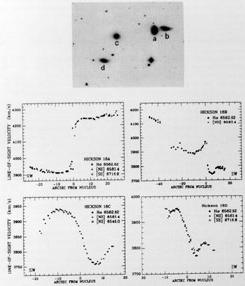


5.3 Rotation Curves for Spiral Galaxies in Compact Groups
The effects of the cluster environment on emission-line rotation curves is subtle, with the outer galaxies showing essentially no effect, and the inner galaxies having outer gradients which are typically 10-30% lower than field galaxies. The two sides of the rotation curves generally match relatively well, indicating the gas is in circular motion. Most of the rotation curves for cluster galaxies would be described as "normal".
In compact groups, where the density is generally as high or higher than in the cores of clusters, and the relative velocities are lower, the effect of the environment on rotation curves is often much stronger. Rubin, Ford, and Hunter (1989) have obtained spectra of 45 galaxies in 16 groups. Of the 33 spirals in the sample, nine are too abnormal to classify, 13 are peculiar or irregular, and only 11 are normal. The rotation curves which are defined as peculiar generally fall into two categories: asymmetric, with the two sides of the rotation curve having very different outer gradients; and sinusoidal, with velocities reversing at large radii and actually going to zero in some cases. Figure 7 shows an image of Hickson 16, along with four of the rotation curves. Hickson 16A is a good example of a galaxy with an asymmetric rotation curve, with one side rising and the other falling. Hickson 16C has a sinusoidal rotation curve. Both 16B and 16D would be in the abnormal category. Rubin, Ford, and Hunter also find that the brightest group member is more likely to have a peculiar or abnormal rotation curve than the dimmer galaxies in the group.

|
Figure 7. Image and emission-line rotation curves for galaxies in Hickson 16. (from Rubin, Ford, and Hunter 1989) |
Rotation curves which are similar to the sinusoidal curves have been observed in the case of the famous merger candidate NGC 7252 by Schweizer (1982), and the interacting pair NGC 450 / UGC 807 by Rubin and Ford (1983). This provides support for the idea that these unusual rotation curves are the result of recent interactions. The large deformities in these rotation curves indicate that the galaxies are not in an equilibrium state, and developing a reasonable mass model is not straightforward. It is therefore not possible to determine whether a dark massive halo is being removed from these galaxies and deposited into the intergroup potential, or whether the galaxy is simply rearranging itself after a severe jolt.
Rubin, Ford, and Hunter have also obtained spectra of 12 elliptical and S0 galaxies in the Hickson groups. They find a very high incidence of extended emission in these galaxies, and in one case (Hickson 23c = NGC 1216), the gas is actually counterrotating with respect to the stellar component. The presence of this gas in generally gas-free system is more evidence for the recent accretion of material from another galaxy during an interaction or merger event.